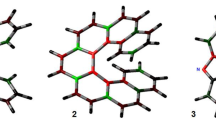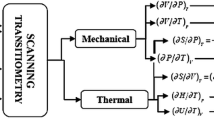Abstract
Four methods: direct, polymerization, condensation and crystallization, are dicussed. that may be applied to measure the parity violating energy difference between enantiomers We find that the best possibility is the crystallization with element of high Z in the asymmetry center.
Similar content being viewed by others
References
Yamagata, Y.: A hypothesis for the asymmetric appearance of biomolecules on Earth,J. Theor. Biol. 11 (1966)495–498.
Keszthelyi, L. Origin of asymmetry of biomolecules and weak interaction,Origins of Life 8 (1977)299–340.
Bonner, W. A. The origin and amplification of biomolecular chirality,Origins of Life and Evolution of the Biosphere 21 (1991)59–111.
Rein, D. W. Some remarks on parity violating effects of intramolecular interactions.J. Mol. Evol. 4 (1974)15–22.
Rein, D. W., Hegstrom, R. A. and Sandars, P. G. Parity violating energy difference between mirror image molecules.Phys. Lett. 71A (1979)499
Tranter, G. E. Parity violating ehergy differences of chiral minerals and the origin of biomolecular homochirality.Nature, 318 (1985)172–173.
MacDermott, A. J. The weak force and the origin of life, in Ponnamperuma, C. and Chela-Flores, J. (eds)Chemical Evolution: Origin of Life, A. Deepak Publishing, Hampton, Virginia, USA, 1993, pp. 85–117.
Quack, M. On the measurement of the parity violating energy difference between enantiomers.Chem. Phys. Letters, 132 (1986)147–153.
Vértes, A. and Nagy, D. L.Mössbauer spectroscopy of frozen solutions. Akadémiai Kiadó, Budapest, 1990.
Salam, A. The role of chirality in the origin of life.J. Mol. Evol., 33 (1991)105–113.
Figureau, A., Duval, E. and Boukenter, A. Search for phase transitions changing molecular chirality. in Ponnamperuma, C. and Chela-Flores, J. (eds)Chemical Evolution: Origin of Life, A. Deepak Publishing, Hampton, Virginia, USA, 1993, pp. 157–164.
Navarro-Gonzales, R., Khanna, R. K. and Ponnamperuma, C. Chirality and the origins of life. in Ponnamperuma, C. and Chela-Flores, J. (eds)Chemical Evolution: Origin of Life, A. Deepak Publishing, Hampton, Virginia, USA, 1993, pp. 135–155.
Keszthelyi, L. Contribution of parity violating effects to intramolecular interactions.Physics Letters, 64A (1977)287–288.
Pincock, R. E., Perkins, R. R., Ma, A. S. and Wilson, K. R. Probability distribution of enantomorphous forms in spontaneous generation of optically active substances.Science, 174 (1971)1018–1020.
Kovács, K. L. On the physical origin of biological handedness.Origins of Life, 9 (1979)219–233.
Kondepudi, D. K., Bullock, R. L., Digits, J. A., Hall, J. K. and Miller, J. M. Kinetics of chiral symmetry breaking in crystallization.J. Am. Chem. Soc. 113 (1993)10211–10216.
Author information
Authors and Affiliations
Rights and permissions
About this article
Cite this article
Keszthelyi, L. Possibilities to measure the parity-violating energy difference. J Biol Phys 20, 241–245 (1995). https://doi.org/10.1007/BF00700442
Issue Date:
DOI: https://doi.org/10.1007/BF00700442




